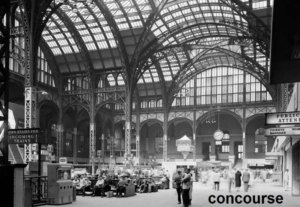So much of how we (and everyone else) turns out is due to happenstance. This story explains how working for equal opportunity makes merit meaningful. Good stuff.
Read it at Vox here.
Image by OpenClipart-Vectors from Pixabay
So much of how we (and everyone else) turns out is due to happenstance. This story explains how working for equal opportunity makes merit meaningful. Good stuff.
Read it at Vox here.
Image by OpenClipart-Vectors from Pixabay
A fascinating explanation of how modern elections turn not on swing voters choosing candidates, but the base voting against the other guys.
Which is why voters who dislike Trump have to remember to vote for the Democratic candidate, no matter who that is, in November. The Republicans, the Russians, the White Supremacists will try to get Dems and Independents to stay home, or vote for a third party candidate.
Don’t get fooled again!
“Only 53 percent of Sanders voters say they will certainly support whomever is the Democratic nominee. This is no idle threat. In 2016, in Pennsylvania, 117,000 Sanders primary voters went for Trump in the general, and Trump won the state by 44,292 ballots. In Michigan, 48,000 Sanders voters went for Trump, and Trump won the state by 10,704. In Wisconsin, 51,300 Sanders voters went for Trump, and Trump won the state by 22,748. In short, Sanders voters helped elect Trump.”
So, who among Democrats siphons votes away from Trump? Bernie seems to be the answer. Brooks says.
You can read his column, which makes a different and not really defensible point, here.
I think the better message is that most people don’t like Trump. Most people are opposed. No matter who the Democratic nominee is, and we may or may not like her or him, we all have to vote for the nominee. That’s the job. None are as bad as the choice of not voting, which is equal to a vote for Trump.
That’s what we all have to remember, even as Republican and Russian and White Supremacist operators pound us with divisive information. There’s better, there’s best, there’s not quite as good. All fine, especially if the alternative is Trump.
I went back to see this show at Bard’s Hessel Center for a second time today. I rushed through the first time, and didn’t quite get all the amazing connections going on here.
This is a show about photographs that digs deep into their documentary value. The first and last images in the loop of an exhibit space are workers entering and leaving their factories.
In between, there is a fantastic survey of photographic imagery working on social issues. Walker Evans and Lewis Hines are here, in the context of their documentary work, and some of Robert Mapplethorpe’s sex pictures are here, too. Plus one of the flowers, because it exists.
Not everything clicks, but everything does get at this idea that pictures and ideas and politics and social understanding, at least, go together.
There is an amazing video, built around Kanye’s Ultralight Beam, that weaves a history of black culture in image and sound that challenges and undermines the very notion of integration. In the way that I Am Not Your Negro does, disdaining the very notion of accommodation.
Martha Rosler’s detournment of women’s roles in American advertising struck me, maybe because this is what I grew up with, and how I learned to distrust the media.
Here’s one of those not in the show. Go if you can.
 The history of resistance is populated by lone wolves, some who are admirable. Some who are truly transgressive.
The history of resistance is populated by lone wolves, some who are admirable. Some who are truly transgressive.
He also lived, after his transgression, something of an exemplary live, serving our society’s greater goals always.
I loved the Anarchist Cookbook when I was a teen, for the assumption of pure power anyone could have by building a bomb. It stroked my teenage dream of blowing things up to make things right.
But we all knew we were small potatoes compared to the international situation. Or we thought we were.
Today we know that a small potato with a big bomb can change everything, and while Powell may have known that, his amazing book is changed by that knowledge from an object of romantic upheaval to a harbinger of terror.
It’s the same thing, but the context changes everything. And I write now of my love for the book without apology, but with a much greater understanding of the obligations and costs of, well, revolution, especially as practiced by someone better equipped to blow stuff up and kill than to actually change things.
Time to head to the basement to find my copy of Abbie Hoffman’s Steal This Book.
Forrest Fenn is a dude, apparently.
He made lots of dough on Southwestern artifacts. You can surely see how that happened.
When he found time to confront his own physical demise, he wrote a poem with nine clues about where he buried a small chest or artifacts worth two million dollars, somewhere out in the wilderness of the Rocky Mountains.
 Where? Idaho, Montana, Colorado, or New Mexico.
Where? Idaho, Montana, Colorado, or New Mexico.
A cult of treasure hunters going after this treasure was inevitable, but so far the most anyone has gotten out of it is a good yarn.
 He promised these things in his speech to Congress. Sounds pretty good. We should not forget, or accept excuses if he fails to deliver:
He promised these things in his speech to Congress. Sounds pretty good. We should not forget, or accept excuses if he fails to deliver:
The way to make health insurance available to everyone is to lower the cost of health insurance, and that is what we are going to do.
Here are the principles that should guide Congress as we move to create a better healthcare system for all Americans.
First, we should ensure that Americans with pre-existing conditions have access to coverage, and that we have a stable transition for Americans currently enrolled in the health care exchanges.
Secondly, we should help Americans purchase their own coverage, through the use of tax credits and expanded health savings accounts, but it must be the plan they want, not the plan forced on them by our government.
Thirdly, we should give our state governors the resources and flexibility they need with Medicaid to make sure no one is left out.
Fourth, we should implement legal reforms that protect patients and doctors from unnecessary costs that drive up the price of insurance and work to bring down the artificially high price of drugs and bring them down immediately.
And finally, the time has come to give Americans the freedom to purchase health insurance across state lines.
Which will create a truly competitive national marketplace that will bring cost way down and provide far better care. So important. Everything that is broken in our country can be fixed. Every problem can be solved. And every hurting family can find healing and hope. Our citizens deserve this and so much more. So why not join forces and finally get the job done and get it done right?
Yesterday the Governor of New York, Andrew Cuomo, announced a new shopping mall and Amtrak station adjoining the James A. Farley Post Office Building, across Eighth Avenue from the current Madison Square Garden. Call it the new Penn Station.
If you’re not familiar with New York you have no idea just what a disaster the current Penn Station, which currently resides under the Garden, is. For one thing, New Jersey Transit, Amtrak and the Long Island Railroad all come through the station, which is a tangle of platforms and stairways and levels, all with low ceilings and a sense of crushing crowdedness.
 For another, it isn’t the glorious station that was built in 1910 and graced the site for 50 years before it was ingloriously torn down by greedy developers, a move that sparked New York’s historic preservation movement cum bureaucracy those many years ago.
For another, it isn’t the glorious station that was built in 1910 and graced the site for 50 years before it was ingloriously torn down by greedy developers, a move that sparked New York’s historic preservation movement cum bureaucracy those many years ago.
If you are familiar with the station, you know all its horrors, but you might not guess that 650,000 people arrive and leave from it every day. It was designed to handle about 200,000.
As someone whose portal into the city when I was growing up was Penn Station, it was always a miserable place to be. Its dismal surroundings were ameliorated somewhat by the fact that you were either leaving or coming, you didn’t linger longer than necessary in Penn Station. Still, sometimes the wait was long.
I don’t know if it is by coincidence or plan, but the New York Times today has an elaborate suggestion for how to fix Penn Station. The beauty of the plan, which was developed by the architect Vishaan Chakrabarti, is to leave the massive cylinder that is Madison Square Garden intact, but to do away with all the innards.
 No concrete shell, no hockey rink, no basketball court. No stairs or escalators. The shell would be replaced with something called blast-proof glass, and the space would be open to the sidewalk. No doors!
No concrete shell, no hockey rink, no basketball court. No stairs or escalators. The shell would be replaced with something called blast-proof glass, and the space would be open to the sidewalk. No doors!
Though in cold weather the station may be sealed off by temporary walls. But the idea is that the sun beating down on a giant glass building would work like a greenhouse. Anyone who has ridden the escalator up with a full complement of luggage to the door on Eighth Avenue and 32nd Street knows how nice the elimination of door would be.
In any case, the Times presentation of this idea, written by Michael Kimmelman, the paper’s architecture critic, is not only beautiful, but it is beautifully presented. If there’s a reason to move from print to digital now, this is it.
And I’m not showing any of it. Be surprised!
I don’t know if I want more for it to be real or to be fake. Either way, brill.
https://medium.com/@shitHRCcantsay/let-me-remind-you-fuckers-who-i-am-e6e8b297fe47#.7w1xv6yxm
Muhammad Ali’s star status was about personality and talent and show biz sense. His historical importance is built on his moral sense, which doesn’t get displayed more clearly and rightly than this: